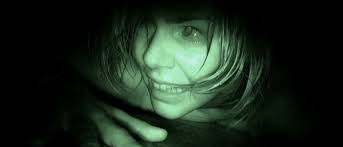‘[REC]’ Reinvented What Found Footage Horror Could Be

Jaume Balagueró and Paco Plaza’s Rec (stylized as [•REC]) is a found footage shocker with bridges to burn. For years, found footage was constrained by its technique. The early successes of the likes of Ghostwatch, The McPherson Tape, and The Blair Witch Project solidified the form. While found footage dates back as early as 1961 with Shirley Clarke’s The Connection, the first bonafide horror example came in 1980 with Ruggero Deodato’s cruel, merciless Cannibal Holocaust. The form continued to evolve, and 16 years ago this month, Spanish audience members were treated to Rec, where it was later recognized by big box office bucks and several Goya Award nominations. Found footage then wasn’t what it is now, and a large part of that has to do with Rec.
In most found footage, the conceit is as follows: footage is recovered from the scene of some horrific and unexplained violent event, and said footage is then slowly fed back to the audience in hopes of piecing together what might have happened. The suspension of disbelief, The Blair Witch Project notwithstanding, rarely works. Often, there’s too much conventional filmmaking prowess on display with the ostensibly recovered footage to suggest a real person recorded it. No one misconstrued Zak Penn’s 2004 feature Incident at Loch Ness, despite the best efforts of writer/producer/star Werner Herzog, as the real deal.
Also Read: ‘Malibu Horror Story’ Director Scott Slone On The Decade-Long Evolution of His Found Footage Film [Watch]
Somewhat incredulously, however, found footage horror often goes to great lengths to make its depiction of frightening phenomena as real as possible. While in the case of something like Noroi: The Curse, this proves to be an asset, the approach too often distracts more than it amplifies. Start asking questions and the entire enterprise falls apart at the seams. Shaky cams, off-screen screams—audiences now know the drill (and the durability of these allegedly recovered cameras). The cheapo camcorder I got for Christmas in 2005 could never. With Rec, Balagueró and Plaza leaned into the tropes, and more than a decade later, it endures as one of the scariest stories ever told within this modality.
The setup is simple. Reporter Ángela Vidal (Manuela Velasco) and cameraman Pablo (Pablo Rosso) are covering the night shift of a local Barcelona fire station for a television series While You’re Sleeping (which I imagine several in-movie Barcelonans turned on expecting to see Sandra Bullock). An old woman trapped in her home sends the pair to a local apartment building alongside smoldering civil servants Álex (Ferrán Terraza) and Manu (David Vert). Quickly, things spiral out of hand, and Ángela and company are trapped in the building along with the other residents. There’s some kind of infection spreading, and in classic zombie fashion, it’s made biters out of seemingly normal folk.
Also Read: Christina Ricci Faces Found Footage Horrors In Shocking New Music Video [Watch]
Where Rec diverges from its found footage brethren of the past—and where it made its stamp on the subgenre of the future—is its commitment to high-octane thrills within the scope of its narrow point of view. Found footage at the time was regularly of the slow-burn variety. Let the scares trickle in before a final reel of nauseating camerawork and chaos. To wit, Cloverfield wouldn’t arrive until a year after Rec, and even then, Paranormal Activity would be released, repositioning gothic pacing as the found footage mantra for years to come.
Rec is lean, mean, and brutal, a cliché, sure, but an apt one. Once Ángela arrives at the apartment building, Rec never slows down to catch its breath. Within the dank and musty corridors, Balagueró and Plaza subvert both zombie and found footage expectations. Their zombies aren’t the undead—broadly, they’re possessed folk, a thread further expounded on in three additional sequels (all of them, especially Rec 2, worth watching). The found footage is kinetic yet stylized, feeling both akin to the found footage form and something more Hollywood, more accessible. It’s close to the scale of what the aforementioned Cloverfield would do, though its scares are more visceral, more up-close.
Bodies are thrown over railings. Infected scurry in and out of shadowy corners, attacking and retreating when audiences least expect. Central antagonist Tristana is a force to be reckoned with, a spindly template for the ghosts and ghouls of the genre moving forward. Blair Witch would copy-paste Tristana into the Black Hills Forest nine years later.
Also Read: ‘Frogman’ Is Cryptid Found Footage Done Right [Popcorn Frights 2023 Review]
So good is Rec, its American remake, dully titled Quarantine, is just as effective. Released one year later, the neutered scares weren’t enough to degrade the promise of the stunningly terrifying architecture Balagueró and Plaza were working in. As a franchise, Rec continued to reinvent itself, eventually abandoning the found footage conceit midway through its third entry, demonstrating its unbridled commitment to subverting expectations and surprising even the most savvy genre audiences.
In the moment, it can be difficult to assess the pulse of any genre. What is the horror of this decade really about (trauma, probably)? What about the last? Classics especially are perhaps too easily inaugurated. It takes time to earn that status, and sixteen years out, it’s easy to see how Rec not only succeeded contemporaneously but has possessed the lifeblood of an entire subgenre of horror. That’s no easy feat, so the next time you sit down to watch the latest in a long line of found footage shockers, give thanks to Rec. Maybe, too, consider letting it possess you all over again.
Rec is now available to rent on Prime Video. Let me know what you think on Twitter @Chadiscollins.
Categorized:Editorials News

